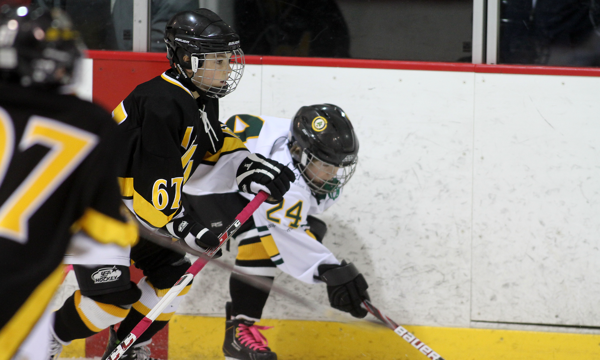As the start of another hockey season approaches, young skaters across the country are daydreaming about scoring goals, winning games and having fun with their buddies on the ice once again.
For the adults – parents, coaches and administrators – while the pending fun and excitement is certainly top of mind, so must be player safety and making sure the season is a memorable one, for all the right reasons. Nobody wants to see young players get injured, so it’s the perfect time to take another look at the preventative measures all in the hockey community can take to ensure the risk of injury is reduced and the fun amplified. It’s also a good time for a reminder about USA Hockey’s Concussion Management Program and Return to Play Forms that were introduced just a few seasons ago.
“Hockey creates such a great environment for the kids. It promotes a healthy lifestyle, impacts their physical, social, emotional and mental well-being and all of that can be affected if they are sick or injured,” said Kevin Margarucci, USA Hockey’s Manager of Player Safety and a certified athletic trainer. “So, we want players to enjoy the game but do it the right way, and if they are hurt, return the right way so they can continue to get the benefits out of the sport.”
What to Look For
Hockey by nature is a physical sport. And as players move up from the lower age groups to the older age groups, physical contact will undoubtedly increase. USA Hockey and the hockey world at large have made progress in approving new player safety rules to help reduce the number of unsuspecting late hits, checks from behind, hits to the head or around the head and other, more violent, actions. But, like any other sport where physical contact is prevalent, injuries, including concussions, will still occur. So, it’s important that everyone in the rink knows what to look for, in order to address a potential concussion in real-time.
According to Margarucci, recognizing the signs and symptoms of a concussion are critical, particularly for non-medically trained individuals, and he advises everyone to get familiar with the Concussion Recognition Tool (CRT 6) which is included in USA Hockey’s Concussion Management Program.
The Concussion Recognition Tool is not designed to diagnose a concussion, but “for the identification and immediate management of suspected concussion.” The Tool outlines “Visible clues of suspected concussion,” such as loss of consciousness, disorientation and confusion, slow to get up after a direct or indirect hit to the head and more. It also clarifies “Symptoms of suspected concussion,” both physical and emotional, such as headache, balance problems, nausea, blurred vision, difficulties concentrating, or a feeling of irritability, sadness, anxiousness or ‘in a fog.’ Finally, the Tool offers several sample questions to ask the injured player, including ‘where are we today,’ ‘who scored last in this game’ and did your team win the last game.’ Failure to answer any of the questions may suggest a concussion has occurred.
What to Do
The Concussion Recognition Tool states that if there are any “red flags,” such neck pain, seizures, loss of vision or consciousness, vomiting or worse, the athlete should be immediately removed from play/game/activity and transported for urgent medical care by a healthcare professional. However, even if there are no visible red flags, Margarucci says it’s important that if adults suspect a possible concussion, to act appropriately.
According to USA Hockey’s Concussion Management Program literature, if the athlete is conscious and responsive, without symptoms or signs of a neck injury, an adult (ideally a healthcare professional, but if necessary, a coach or parent) should help the player off the ice to the locker room, perform an evaluation (using CRT 6) and not leave them alone. Any player with any symptoms or signs of concussion should not be allowed to return to play on the day of injury. If symptoms worsen over time, take the player to the ER. The golden rule? “When in doubt, sit them out.”
How to Return to the Ice Safely
Among USA Hockey’s available informational tools related to concussion prevention and management are return to sport and return to learn strategies. The return-to-play strategy outlines the various steps and increasing levels of activity that players must progress through. Per Margarucci, it’s a graded return to activity, that starts with a gradual reintroduction of work and school activities – daily activities, like walking, that do not exacerbate symptoms and progresses from there.
“It’s a three-pronged approach to returning to play,” said Margarucci. “Once the return to sport progression is complete the Return to Play Form is a requirement a physician must sign off on that the player can return to play without restriction. The parent also must sign the form, thereby consenting that the player can return to play based on the physician’s clearance. And, then a coach signs to acknowledge that they’ve received it and that it’s okay to put the athlete back on the ice.”
Margarucci believes it is critical that everyone, including teammates, play a part in looking out for each other on the ice.
“A teammate with a concussion is someone who needs help and players, regardless of age, should speak up if they think a player has a concussion or any other injury,” he said. “We want to educate parents, coaches and players to create a circle of people involved in youth sports that can help identify issues, pull that player out and ultimately, do the right thing.”
Remember, it’s better to miss one game than the whole season! Stay safe, have fun and good luck!
For more information, visit https://www.usahockey.com/safety-concussions.



